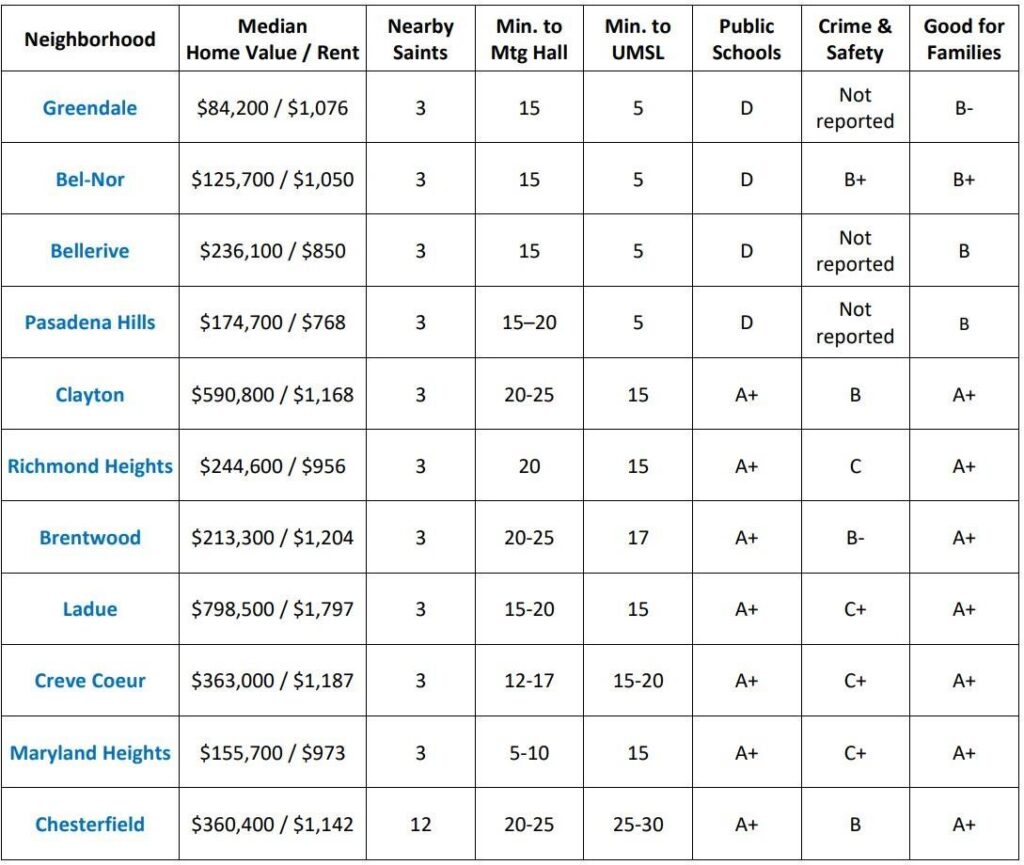St. Louis, MO

Overview
The saints began to meet in St. Louis in the 1960s and took the ground on May 18, 2003. On average, 62 saints gather on Lord’s Day mornings, including approximately 15 young people and 13 children (including infants), and about 20 saints attend the weekly prayer meetings. During the week, there is a neighborhood children’s meeting, a Saturday young people’s meeting, and various group meetings (English-speaking and Chinese-speaking).
The church in St. Louis is endeavoring to build up the church in truth, life, gospel, and service, as well as laboring on the children, students (young people and college-age), and community. The church is endeavoring to build up the organic structure of the church through vital living, vital groups, and small groups and is looking to the Lord for additional strengthening of the leadership and more shepherding saints to join us as patterns of the flock.
The burden of the college work is to gain typical Missourians at the University of Missouri–St. Louis (UMSL) and to care for the saints attending Washington University in St. Louis (WashU). The saints recently had Bible distributions at UMSL when the campus reopened in person.
Location, Climate, and Health
St. Louis is located along the western bank of the Mississippi River, which forms the state line between Missouri and Illinois. The region’s driving times to several localities are Chicago, IL—4:45; Champaign, IL—3:00; Normal/Peoria, IL—3:00; and Kansas City, MO—4:00.
St. Louis has four distinct seasons. Spring is pleasant, with highs in the 70s and blooming flowers and trees throughout the region. Summer is humid, with highs averaging in the 80s. Fall is comfortable, with highs averaging in the 70s and a great deal of fall color. Winters are cold, with lows in the 20s and usually around four days of snow yearly. The average annual rainfall is about 42 inches. Tornadoes are a significant weather phenomenon due to St. Louis’ location in the Great Plains region.
St. Louis has three major healthcare systems: BJC HealthCare (affiliated with WashU), SSM Health St. Louis (affiliated with SLU), and the Mercy Health System, a high-quality nonprofit healthcare organization.
Demographics
The city of St. Louis has a population of about 300,000, and the metro area has a population of about 2.8 million. The St. Louis metropolitan area is the most populated in Missouri. The city population has declined since its peak in the 1950s, and job and population growth has mainly occurred west of city limits. The racial makeup of the city of St. Louis is 47% Black, 46% White, 4% Hispanic or Latino (of any race), and 3% Asian. The racial makeup of St. Louis County is 66% White, 24% Black or African, 3% Asian, and 4% Hispanic or Latino. The St. Louis metro area is predominantly Christian, with approximately 75% of adults identifying with a Christian faith group.
Economy/Employment
The economy of St. Louis has a variety of sectors. The 2017 gross domestic product (GDP) of St. Louis was $161.3 billion, the 22nd-highest GDP in the United States. According to the 2017 Economic Census, manufacturing in the city conducted nearly $11 billion in business, followed by the healthcare and social service industry with $3.5 billion, professional or technical services with $3.1 billion, and the retail trade with $2.5 billion. The sector employing the most significant number of workers in the city was healthcare with 34,000 workers, followed by administrative and support with 24,000 workers, manufacturing with 21,000 workers, and food service with 20,000 workers. As of September 2019, St. Louis had nearly 1.5 million workers in its labor force, with an unemployment rate of 2.6%.
The following are some of the top companies to work for in St. Louis:
| *Emerson Electric | *Jones Financial | Boeing | WashU and BJC Healthcare |
Scott Air Force Base |
| *Express Scripts | *Reinsurance Group of America |
Panera Bread | SLU and SSM Health | Wells Fargo Advisors |
| *Centene | *World Wide Technology |
Enterprise | Mercy Health | HOK |
| *Monsanto | *Ameren | Nestlé Purina | Anheuser-Busch |
*Current corporate headquarters are located in St. Louis
The median home price in St. Louis County is $300,000, and its cost of living index is below that of most major cities in the US. The income tax rate in Missouri is progressive and ranges from 1.5 to 5.9%. The sales tax is 9.68% in the city and 4.23% in the county.
Transportation
St. Louis Lambert International Airport (STL) is a major hub for Southwest Airlines, and the following airlines also fly out of STL: American Airlines, Delta Airlines, United Airlines, Air Canada Express, Air Choice One, Alaska Airlines, American Eagle, Cape Air, Contour Airlines, Frontier Airlines, and Sun Country Airlines.
The Metro, the St. Louis public transportation system, includes bus and light rail services. The light rail serves the airport, the major stadiums, and downtown St. Louis and crosses the Mississippi River to serve southern Illinois. Both Uber and Lyft operate in St. Louis, along with bike share and scooter share services.
The automobile is still the predominant way to get around St. Louis. Two interstate highways intersect in St. Louis: I 70 and I-55. St. Louis experiences very low congestion among the top 50 major cities in the United States.
Campuses
St. Louis is home to three significant campuses, which are located 5 to 10 miles away from each other: the University of Missouri, Saint Louis(UMSL), Washington University in Saint Louis (WashU), and Saint Louis University (SLU).
UMSL (student population of 15,000): UMSL is the only public university in St. Louis. Bachelor’s, master’s, and doctoral degree programs are offered through the College of Arts and Sciences, the College of Business Administration, the College of Education, the College of Nursing, the School of Social Work, and the College of Optometry. UMSL College of Optometry is one of 17 optometry schools in all North America.
WashU (student population of 15,000): Founded in 1853, WashU is a private research university in the Greater St. Louis area. WashU was recently ranked in the top 20 US universities, according to US News and World Report. In addition, WashU was ranked 8th in the nation in medicine, 18th in law, 26th in business, 10th in architecture, and 2nd in social work. Starting fall 2020, WashU will provide free education to any accepted student from Missouri or southern Illinois whose family income is under $75,000. This could be a great benefit for those with high school children considering migrating to St. Louis.
SLU (student population of 13,000): SLU is a private Roman Catholic research university with campuses in St. Louis and Madrid, Spain. The university is ranked 96th in the nation by US News and World Report, and the SLU School of Medicine is ranked 57th among US medical schools.
St. Louis Community College (STLCC) has eight campuses in the St. Louis area.
Other colleges in the St. Louis area include Harris-Stowe State University (a historically Black public university), Webster University, Maryville University, Fontbonne University, St. Louis College of Pharmacy, and Missouri Baptist University.
Schools
The St. Louis metro area has multiple school districts that span the full spectrum of education quality. The top-rated public school districts in the area are Clayton School District, Ladue School District, Parkway C-2 School District, and Brentwood School District. St. Louis also has several highly rated private schools.
Housing
The saints burdened for the campus work are encouraged to look for housing near WashU or UMSL. The neighborhoods near WashU and SLU are Clayton, Richmond Heights, and Brentwood. These neighborhoods are near several grocery stores, retail stores, and restaurants(i.e., Whole Foods, Trader Joe’s, Target, etc.). Most houses in these areas are older (built in the early to mid-1900s), but in recent years, many developers have been renovating existing homes or building new construction.
Houses in the UMSL area (Greendale, Bel-Nor, Bellerive, and Pasadena Hills) are lower in costs than those in the WashU area; however, the school districts are not rated highly. The WashU area is relatively close to all three major universities and has good school districts; therefore, the cost of housing is higher.
The church meeting hall is in a central location and is within a 20-minute drive from most areas of the city and St. Louis County. The saints are scattered throughout the city and county; those migrating are encouraged to live near the campus or the saints. Please get in touch with the brothers for more detailed information.
In addition to low gasoline and electricity prices, affordable housing can incentivize those considering migrating from the West or East coasts. Real estate in St. Louis ranges widely in price and is 3.2% lower than the national average cost of living. Most residents of the St. Louis metropolitan area live in St. LouisCounty—the area surrounding the city of St. Louis—in single-family homes. Most residents of St. Louis own their homes due to a history of low risk of depreciation in property value and generally lower mortgage payments when compared to the cost of rent.
Contact: Noah Lee
Church in St. Louis, 11510 Old St. Charles Rd, Bridgeton, MO 63044
Email: info@churchinstlouis.org
Website: http://www.churchinstlouis.org
